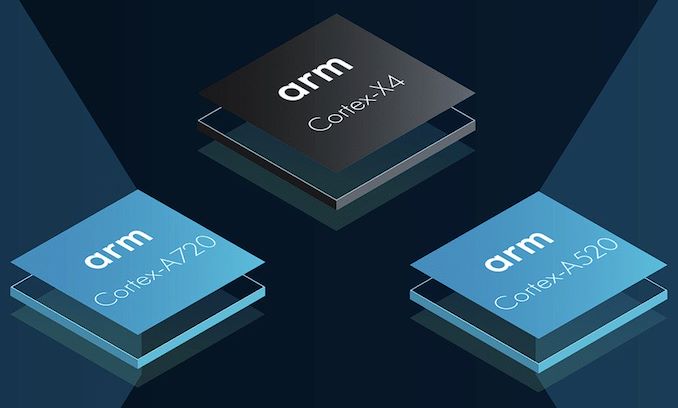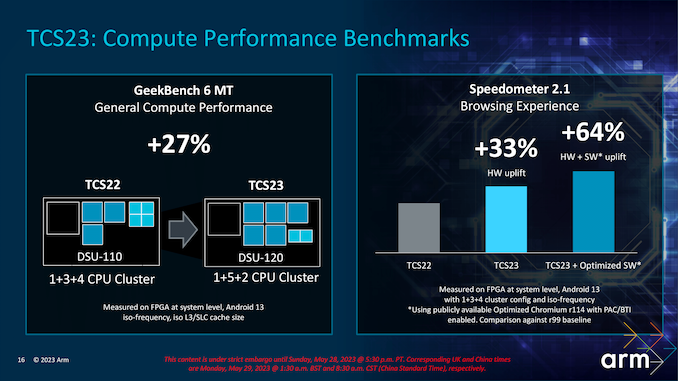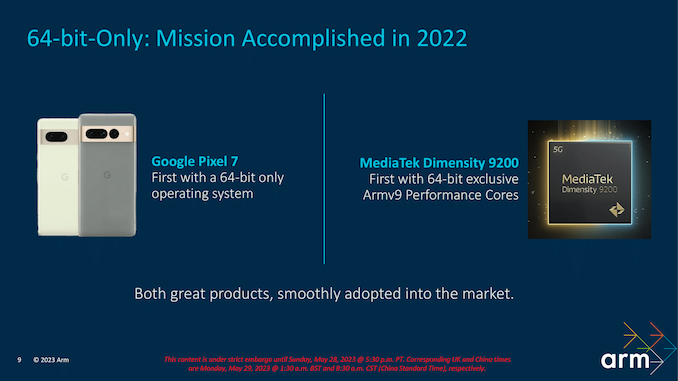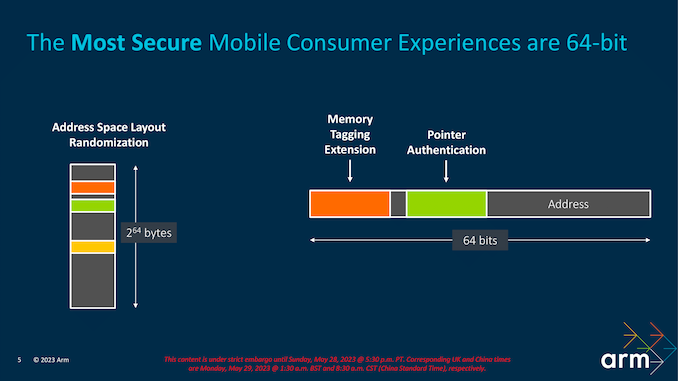Arm Unveils 2023 Mobile CPU Core Designs: Cortex-X4, A720, and A520 - the Armv9.2 Family
by Gavin Bonshor on May 28, 2023 8:30 PM EST
Throughout the world, if there's one universal constant in the smartphone and mobile device market, it's Arm. Whether it's mobile chip makers basing their SoCs on Arm's fully synthesized CPU cores, or just relying on the Arm ISA and designing their own chips, at the end of the day, Arm underlies virtually all of it. That kind of market saturation and relevance is a testament to all of the hard work that Arm has done in the last few decades getting to this point, but it's also a grave responsibility – for most mobile SoCs, their performance only moves forward as quickly as Arm's own CPU core designs and associated IP do.
Consequently, we've seen Arm settle into a yearly cadence for their client IP, and this year is no exception. Timed to align with this year's Computex trade show in Taiwan, Arm is showing off a new set of Cortex-A and Cortex-X series CPU cores – as well as a new generation of GPU designs – which we'll see carrying the torch for Arm starting later this year and into 2024. These include the flagship Cortex-X4 core, as well as Arm's mid-core Cortex-A720. and the new little-core Cortex-A520.
Arm's latest CPU cores build upon the foundation of Armv9 and their previous Total Compute Solution (TCS21/22) ecosystem. For their 2023 IP, Arm is rolling out a wave of minor microarchitectural improvements through its Cortex line of cores with subtle changes designed to push efficiency and performance throughout, all the while moving entirely to the AArch64 64-bit instruction set. The latest CPU designs from Arm are also designed to align with the ongoing industry-wide drive towards improved security, and while these features aren't strictly end-user facing, it does underscore how Arm's generational improvements are to more than just performance and power efficiency.
In addition to refining its CPU cores, Arm has undertaken a comprehensive upgrade of its DynamIQ Shared Unit core complex block, with the DSU-120. Although the modifications introduced are subtle, they hold substantial significance in terms of improving the efficiency of the fabric holding Arm CPU cores together, along with extending Arm's reach even further in terms of performance scalability with support for up to 14 CPU cores in a single block – a move designed to make Cortex-A/X even better suited for laptops.
With three new CPU cores and a new core complex, there's a lot to cover. So let's dive right in.
Arm TCS23 at a High Level: Pushing Efficiency & Going Pure 64-bit
Expanding on the enhancements introduced in the Armv9.1 architecture last year, Arm is progressing through its scheduled development cycle with the latest Armv9.2 architecture. The primary objective of this cycle is to eliminate support for 32-bit applications and transition to a comprehensive 64-bit platform. Underpinning this transition is Arm's strategic framework, "Total Compute Solutions" (TCS), which revolves around three core principles: compute performance, security, and developer access. This approach forms the foundation for Arm's methodology and guides its efforts in delivering optimal performance, robust security measures, and streamlined developer capabilities.
Arm's focus on phasing out the 32-bit instruction set has been one it has been working towards for several years. For their latest TCS23, they have finally created a fully 64-bit cluster to capitalize on the benefit of a complete 64-bit mobile ecosystem, excising AArch32 (32-bit instruction) support entirely.. So whether it's a big, mid, or little core, for Arm's latest generation of IP there is only AArch64.
Developing a dynamic system-on-a-chip (SoC) that caters to a broad spectrum of mobile devices, ranging from cutting-edge flagship smartphones to entry-level models, necessitates a meticulous and consistent approach to maintaining competitiveness in a rapidly expanding market. In the realm of flagship devices, for instance, Qualcomm's Snapdragon 8 Gen2 SoC stands out, leveraging a cluster of Arm's Cortex-X3, Cortex A715/710, and Cortex-A510 cores. The upcoming iteration of Qualcomm's Snapdragon 8 Gen3 and other SoC manufacturers are poised to harness the power of Arm's TSC23 core cluster and intellectual property to further enhance performance in the subsequent generation of flagship mobile devices.
Arm's latest DynamIQ Shared Unit, DSU-120, offers support for up to 14 CPU cores in a cluster, which opens the door to a significant number of different CPU core combinations. We'll see what SoC vendors have opted for later this year, but one probably configuration is a 1+5+2 (X4+720+520), which is likely a configuration for a high-end smartphone. Compared to a last-generation 1+3+4 cluster (X3+715+510), Arm is claiming an uplift of 27% in compute performance within GeekBench 6 MT and a more considerable uplift of between 33% and 64% in the Speedometer 2.1 benchmark depending on software optimizations implemented.
Focusing more on the approach to 64-bit migration, last year Arm announced their first AArch64-only CPU core, the Cortex-A715. Consequently, last year saw the release of the first 64-bit only products, such as MediaTek's Dimensity 9200 SoC, as well as Google's Pixel 7 – which was 64-bit only as a platform choice rather than an architectural restriction.
That said, actual AArch64 adoption/use within the larger software ecosystem has been slower than expected, primarily due to the Chinese market being slow to make the switch from 32-bit to 64-bit. Google has actually been key with its application storage (Google Play) by requiring its developers to submit 64-bit apps as far back as 2019, while also allowing the use of 32-bit applications on devices without native 64-bit support. Other markets haven't been as quick in doing so, but Arm claims that it is 'nudging' companies such as OPPO, Vivi, and Xiaomi to adopt AArch64 faster, which is believed to have the desired effect.
With the initial Armv9 architecture, Arm made improvements to security through the use of its Memory Tagging Extension (MTE) (Armv8.5), which is a hardware-based implementation that uses Pointer Authentication (PA) extensions to help protect from memory vulnerabilities. Memory-based vulnerabilities have been a consistent threat to hardware-based security for many years, and it is something Arm is continually developing within its IP to help mitigate these types of attacks. For reference, Google's Chromium Project claimed that around 70% of high-severity bugs are from memory.
One of the related security features of the latest Armv9.2 architecture is the introduction of a new QARMA3 Pointer Authentication Code (PAC) algorithm. Arm claims the newer algorithm reduces the CPU overhead of PAC to less than 1%, even on their little cores, giving developers and handset vendors even less of a reason to not enable the security feature. Most of these improvements revolve around hardware integrity and security, with a combination of MTE and native benefits through the 64-bit instruction and architecture, all designed to make devices even more secure going into 2023 and beyond. This fits with Arm's ethos to encourage a full switch to 64-bit over a hybrid 64 and 32-bit marketplace.
Finally, looking at performance, Arm claims that their latest generation CPU and core complex architecture has made solid gains in power efficiency. At iso-performance, Cortex-X4 offers upwards of a 40% reduction in power consumption versus Cortex-X3, while Cortex-A720 and A520 save 20-22% over their respective predecessors. On the DSU-120 hub itself, Arm claims an 18% improvement in power efficiency.
Of course, most of these power savings are going to instead be invested in additional performance. But it goes to show what SoC and handset vendors can aim for in this generation if they focus singularly on power efficiency and battery life.
















52 Comments
View All Comments
Silver5urfer - Monday, May 29, 2023 - link
It is not related to the UI, it is related to the worst practices in ARM, Apple.Disposable goods, non compute focused, rather a simplistic tool for the Technological dependency rather than using it like a computer and most importantly, owning your own data in the case of an ARM powered smartphone - Filesystem, Applications control Etc. None of these are present in iOS. And they are now incorporated into the Android heavily from the UI, Design philosophy, Technology.
Axing 32Bit OS / Applications and forcing everyone to be on the Playstore mandated policies gives an edge to Android on axing the power user features, i.e targeting latest OS SDK means you are restricted heavily to an OS and its jail. Also they are hiding applications now on Playstore. That means old apps are now hard to find, and good apps do not work on latest OS (Timey app for eg), and lot of examples. Plus now modern Android blocks you even on Sideload notifying the SDK target version in normal terms such as this app won't work properly because Android 14 and up do not allow Android 6 below apps.
Windows enjoys the superior user retention and proper computing because of it's legacy support, A Windows 3.1 .exe will work on Windows 10. But on Apple it's all outdated and even hardware, any x86 processor from Core2Quad which lacks SSE4 and AVX2 still runs modern games which utilize these features but can be made to work because of the power of x86 and Windows. That's how a superior computer is born but not guardrails and heavy restriction and placing consumer in the dark in the name of technology BS.
Eliadbu - Monday, May 29, 2023 - link
Legacy support is overrated for vast majority of the user base, even on windows. its also a thing that can be achieved with emulation for the niche use cases. Most of the argument you gave had little to non to do with 32 bit support. This legacy support costs in silicon space, complexity and software upkeep - all of those resources can be used for actually useful things that will benefit most users.TheinsanegamerN - Wednesday, May 31, 2023 - link
LMAO legacy support is the only reason windows still exists.iAPX - Monday, May 29, 2023 - link
Intel is thinking about being 64bit-only too, with the X86S project.This is an interesting way, as 16bit and 32bit compatibility could be offered through software emulation in a VM (their proposal), naturally with impact on performances.
Silver5urfer - Monday, May 29, 2023 - link
I hope that project doesn't fly but looking at modern Intel with their ARM clone of P+E to worst now P+E+LPE cores they may break the whole 32Bit Application world.Only HPC market can stop it but looking at how Windows 10 is now being retired by 2030 max (LTSC 1809 maximum lifecycle) add maybe ESU channel like Win7 to 2033 at best, after that I think Windows will also copy Apple hard they are already doing it hardcore as Windows 11 is the Win10S branched out because those internal designers are cultists of the Applesque systems lock down and uber simplification of power user nature, this makes entire generations of young population being dumbed down by the basic structure of the OS + Technology rather than innovative and explorative thinking process of the older era (XP, 7 etc)
Windows 10 is the last Microsoft OS that has real support of all the older Windows applications, 11 discarded a lot of Shell32 / Win32 systems and ruined the NTKernel in the process and the CPU schedulers. They sabotaged the entire explorer.exe too, and with the modern fad AI introduction into the OS the telemetry will explode into exponential factor and with the complete dumbing down of the OS and the process, Atomization of the human thinking will lead to regressive computation. Really unfortunate.
Emulation means there will be a performance penalty.
stephenbrooks - Monday, May 29, 2023 - link
I'm interested by the ARM laptop direction (the 10 X4 plus 4 mid-core design). That could run a full OS like Windows or Linux.eastcoast_pete - Monday, May 29, 2023 - link
At least Gavin addressed the mini-elephant in the room for the small cores (thanks!): still no out-of-order design. Instead, an ALU is removed "for greater efficiency". By now, I am suspecting that ARM and Apple have some kind of understanding that ARM little cores won't, under any circumstance, be allowed to come anywhere close to challenging Apple's efficiency cores in Perf/W. Apple's efficiency cores have about twice the IPC of the little ARM cores and all at about the same power draw. Which made the impossible come true: I am now rooting for Qualcomm to kick ARM's butt, both in court and in SoCs.name99 - Monday, May 29, 2023 - link
Oh FFS, always the conspiracy theories!It’s really much simpler — Apple’s small cores are much larger than ARM’s small cores. ARM seems to be thinking that their mid cores (A720) can play the role of Apple’s small cores, and that may be to some extent true in that Apple can split work between big and small in a way that Android cannot, given that Apple knows much more about what each app is doing (better API for specifying this, and much more control of the OS and drivers).
Much more interesting is how this is all about essentially catching up to Apple’s M series. Which is fine, but if you look at what Apple is doing, the action is all at the high end. I’ve said it before and will say it again; Apple has IBM-level performance in its sights. The most active work over the past three years is all about “scalability” in all its forms, how to design and connect together multiple Max class devices to various ends. The next year or two will be wild at the Apple high end!
Kangal - Monday, May 29, 2023 - link
Thank you!However, I still welcome the development of a smaller and slower ARM core, if it means small power draw and small silicon area. There is a market for that outside of phones; in embedded devices, watches, wearables, and ultra low power gadgets.
We used to have something like Cortex-A7 (tiny), Cortex-A9 (small), Cortex-A17 (medium). Then we had Cortex-A35 (tiny), Cortex-A53 (small), Cortex-A73 (medium). But we never got a successor for the Cortex-A35, so perhaps a very undervolted Cortex-A520 will work. Just like how ARM justified using an overclocked Cortex-A515 as a legitimate successor to the Cortex-A53 range.
Almost all the attention goes to the (Medium) cores. It's their bread and butter. From the development of (2016) Cortex-A73, A75, A76, A77, A78, A710, A720 (2023).
But as you said, the exciting things are happening at the high-end (LARGE) cores. It's started with the creation of a new category in the X1, X2, X3, X4 designs. They seem unfit in phones, okay in tablets, and necessary for ARMbooks. Even then, their performance is somewhere far from Apple's M1/M2/M3 and unfit to tackle AMD Zen3 / Intel 11th-gen x86 cores. Let alone their newest variants.
back2future - Tuesday, May 30, 2023 - link
"Even then, their performance is somewhere far from Apple's M1/M2/M3 and unfit to tackle AMD Zen3 / Intel 11th-gen x86 cores."without sufficient support for desktop OS on desktop performance CPUs it reduces possibilities to binary translation/multiarch binaries and ISA specific OS from vendors, but not on ARM generally having a free choice for Windows/Linux/Unix variants that suit individual needs (work&development/media/gaming)